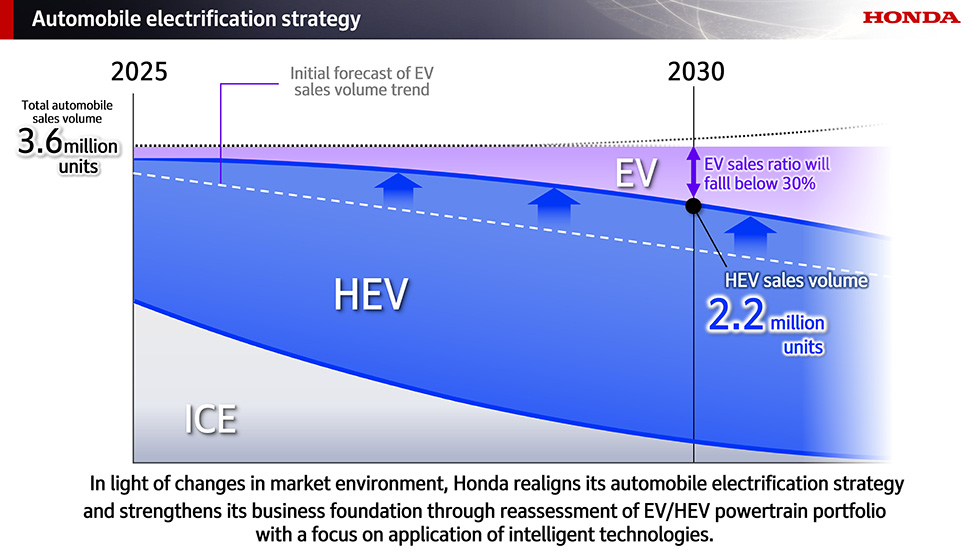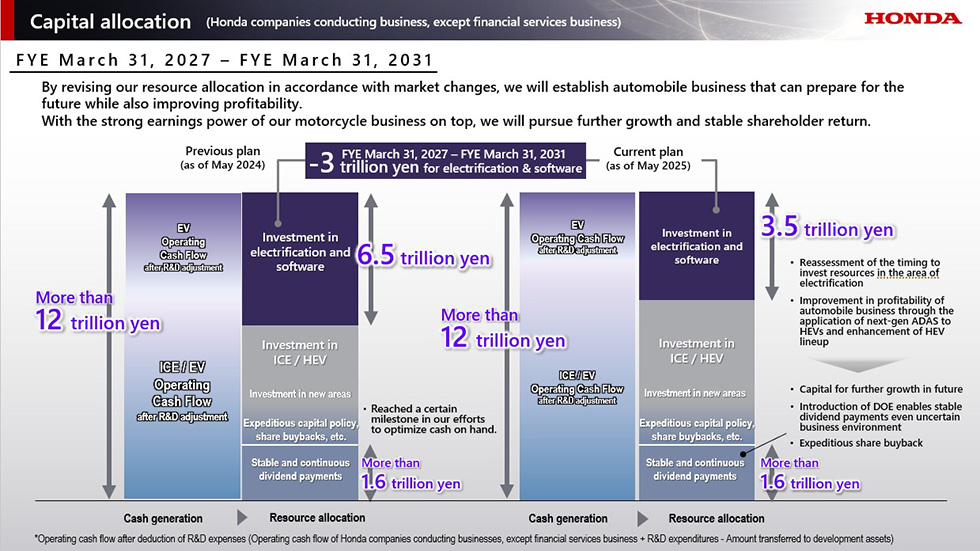- Honda Motorcycle & Scooter India
- HMSI
- Honda Motor Co
- Toshihiro Mibe
- electrification
- ADAS
- Nissan
- Mitsubishi Motors
Honda Reassesses Electrification Strategy Amid Shifting Global Market Dynamics
- By Nilesh Wadhwa
- May 20, 2025

Japanese automotive major Honda Motor Co, has announced a strategic realignment of its electrification roadmap, responding to evolving global market conditions and regulatory landscapes.
In a recent business briefing, Toshihiro Mibe, Director, President and Representative Executive Officer (Global CEO), emphasised on the company's commitment to achieving carbon neutrality and zero traffic fatalities by 2050, while adapting to current challenges.
He reiterated that Honda's initial target to achieve 100 percent global sales of electric vehicles (EVs) and fuel cell electric vehicles (FCEVs) by 2040 remains unchanged. However, the company acknowledges a slower-than-anticipated adoption of EVs, particularly in the United States and Europe, due to relaxed environmental regulations and market uncertainties.
Conversely, hybrid-electric vehicles (HEVs) are experiencing increased demand, offering a practical solution for reducing CO2 emissions without the immediate need for extensive charging infrastructure.
Two-pronged strategy
To navigate these shifts, Honda has outlined two primary strategic directions:
-
Enhancing EV and HEV Competitiveness: Honda aims to integrate intelligent technologies into its EV and HEV models, focusing on advanced driver assistance systems (ADAS) and connected services to deliver new value to customers.
- Reassessing Powertrain Portfolio: The company plans to diversify its powertrain offerings, balancing the development of EVs, HEVs and internal combustion engine (ICE) vehicles to meet varying regional demands and regulatory requirements.
Recognising the scale of investment required for electrification and intelligent technologies, Honda is exploring strategic partnerships, including ongoing discussions with Nissan and Mitsubishi Motors. While a full business integration is not currently planned, these collaborations aim to strengthen shared technological capabilities and market presence.

The Japanese automaker which had announced an ambitious plan to invest 10 trillion YEN towards establishing a robust EV value chain, exemplified by its planned battery-focused project in Canada. Now, the company has revised the CAPEX to 7 trillion YEN till 31 March 2031.
“As for EVs, due to the recent market slowdown, our EV sales ratio in 2030 is now expected to fall below the previously announced target of 30 percent. On the other hand, the demand for HEV models is high. Therefore, we will position our HEVs, mostly next-generation HEV models which we will introduce in 2027 onward, as a group of products that will play a key role during the transition period towards the popularisation of EVs,” said Mibe.

The company targets total automobile sales volume of 3.6 million units, with a HEV sales target of 2.2 million units by 2030.
Two-wheeler sales
Honda Motor Co. announced that its global two-wheeler sales reached a record 20.57 million units for the FY2025, capturing approximately 40 percent of the global two-wheeler market. The company set new all-time sales records in 37 countries and territories, reinforcing its leadership position in the two-wheeler segment.
Looking ahead, Honda expects continued growth in global motorcycle demand, particularly across the Global South, with India – a key market with a growing population and rising income levels – at the forefront. Industry-wide sales are projected to increase from the current 50 million units to approximately 60 million by 2030.
To capitalise on this growth, Honda plans to introduce a broader range of two-wheelers tailored to the varied needs of global customers. It will also optimise its supply chain to ensure more efficient delivery of both internal combustion engine (ICE) and electric models.
As part of its commitment to environmental leadership, Honda is accelerating the electrification of its motorcycle lineup. This includes improving fuel efficiency in ICE models and expanding its range of flex-fuel compatible options.
In early 2025, Honda launched the Active e: and QC1 electric models in India. The CUV e: and ICON e:, designed as global electric commuter models, have already rolled out in Indonesia, Vietnam, Thailand and the Philippines, with plans to expand to Europe and Japan later this year.
In a major strategic move, Honda will begin production of electric motorcycles at a dedicated, high-efficiency plant in India starting in 2028. This facility will focus on modularised models developed exclusively for electric platforms, aiming to boost affordability and scalability in electric two-wheelers.
Through these initiatives, Honda aims to broaden access to electric motorcycles, ultimately targeting the top position in the global electric motorcycle market.

By continuing to launch competitive products and strengthening its supply chain for both ICE and electric vehicles, Honda is positioning itself for long-term profitability. The company aims to achieve a 50 percent global market share and a return on sales (ROS) exceeding 15 percent by fiscal year 2031.
Neusoft And MapmyIndia Partner For Intelligent Mobility Solutions
- By MT Bureau
- December 06, 2025

Chinese technology company Neusoft Corporation and Mappls MapmyIndia have signed a Memorandum of Understanding (MoU) to leverage their strengths in software and data resources to collaborate deeply.
The companies will engage in joint technological development, ecosystem collaboration and resource integration to provide navigation products and intelligent mobility solutions tailored to localised needs in emerging markets such as Southeast Asia and India.
The partnership is a response to the fact that while global auto brands are expanding into Southeast Asia and India, they face challenges in these regions due to complex road conditions, unique traffic rules, extensive addressing systems and high localisation adaptation costs. These issues limit the ability of automakers to deliver a complete intelligent user experience.
Under the collaboration, Neusoft will adopt its OneCoreGo Global Intelligent Mobility Solution 6.0 Plus as the core technology carrier, deeply integrating MapmyIndia's map data, real-time traffic information and multi-dimensional value-added services. MapmyIndia is noted as the largest local mapping company in India, holding more than 90 percent market share in in-vehicle navigation.
The integration is intended to strengthen a full capability loop of ‘navigation + payment + interaction + connectivity + operations’.
Through API integration and technological convergence, the two parties will jointly develop navigation products and mobility solutions highly adapted to Southeast Asia, India and similar regional markets. These solutions will deliver precise route planning and real-time traffic guidance, address local user needs and continuously enhance product experience and scenario-based services. This will help automotive partners rapidly launch intelligent vehicle models with competitiveness in local markets.
The partnership enables Neusoft to combine the global end-to-end strengths of its solution with localised ecosystem resources, paving the ‘last mile’ for automakers entering the Southeast Asian and Indian markets and delivering comprehensive intelligent mobility experiences.
- Ultraviolette Automotive
- Zoho Corporation
- Lingotto
- F77
- X-47
- Shockwave
- Tesseract
- Narayan Subramaniam
- Niraj Rajmohan
Ultraviolette Secures $45 Million Growth Capital From Zoho And Lingotto
- By MT Bureau
- December 04, 2025

Bengaluru-based electric vehicle maker Ultraviolette Automotive has secured USD 45 million from Zoho Corporation and Lingotto, one of Europe's investment management companies as part of its ongoing Series E investment round.
The investment from Zoho Corporation was led by Sridhar Vembu, Mani Vembu and Kumar Vembu.
This growth capital will accelerate the domestic and international scale-up of current products F77 and X-47, as well as future product platforms Shockwave and Tesseract.
Ultraviolette has built a design and technology-led enterprise with the F77 and the recently launched X-47.
The company has expanded to 30 cities across India in a short span of 12 months and is expanding to 100 cities by mid-2026. The F77 motorcycles were recently launched in the United Kingdom, bringing Ultraviolette's presence to 12 countries across Europe.
Narayan Subramaniam, Co-Founder & CEO, Ultraviolette Automotive, said, “We are glad to announce our Series E investment from Zoho and Lingotto. Lingotto's legacy of backing iconic performance and mobility brands, combined with Zoho's long-term commitment to fostering cutting-edge Indian innovation, aligns perfectly with Ultraviolette's mission to build category-defining electric mobility solutions for India and global markets.”
Niraj Rajmohan, CTO & Co-Founder, Ultraviolette, said, "With the ongoing Series E investments, we are doubling down on growth and expanding our production to meet increasing demand. Our focus is on advancing breakthrough battery technology, elevating performance capabilities and expanding production to support upcoming product platforms. This investment will accelerate our journey towards scaling into India and global markets."
Disseqt AI Partners Tata Technologies And Infosys For Agentic AI Adoption
- By MT Bureau
- December 04, 2025

Agentic AI platform Disseqt AI has announced a partnership with Tata Technologies and Infosys. As per the agreement, Disseqt AI will assist both companies' IT and DevOps teams in developing and fast-tracking the production of tailored Agentic AI applications for automobile and FinTech companies globally.
The partnership aims to help auto and FinTech firms embrace customised Agentic AI faster and in a secure manner.
Disseqt AI, which has operations in Bengaluru, San Francisco and Dublin, provides an enterprise-grade platform for IT and DevOps teams. The company claims its platform cuts down Agentic AI testing and operations cost by 70 percent and improves productivity by up to 80 percent. The platform allows these teams to test, simulate and monitor their Agentic AI systems tailored across industries, ultimately enabling enterprises to operationalise tailored Agentic AI faster and at scale, without sacrificing ethics, governance and compliance.
Apoorva Kumar, Founder and CEO, Disseqt AI, said, “This is a landmark announcement for us as we further embed Disseqt into enterprise workflows for testing, simulation, monitoring and auditability purposes. We are already working closely with both Tata and Infosys on several projects and are proud to be part of their innovation initiatives”
Last month, Disseqt AI announced a strategic collaboration with HCLTech and Microsoft to guide financial services institutions with Agentic AI adoption.
Battery Passport Implementation Beyond EVs To Be Focus Of Barcelona Event
- By MT Bureau
- December 03, 2025

Battery and Energy Storage Europe has announced a programme focused on the EU Battery Passport, a regulatory milestone that becomes mandatory in February 2027. The Barcelona-based event will address the compliance gap for applications beyond the electric vehicle (EV) sector, which have dominated the conversation to date.
The event, taking place on 8th and 9th September 2026 at Fira de Barcelona's Gran Via venue, will focus on solutions and talks for applications that fall within the regulation's scope: stationary energy storage, industrial batteries, grid-scale systems, long-duration energy storage and emerging applications in aerospace, maritime and rail electrification.
With the February 2027 legal requirement date approaching, the programme will bring together industry leaders, technology providers, and policy experts to address the compliance challenges facing these diverse sectors.
The Battery Passport is a digital record documenting a battery's entire lifecycle, from raw material sourcing to production, performance and eventual recycling. From February 2027, it becomes mandatory for all rechargeable EV, industrial and LMT batteries over 2 kWh sold in the EU.
Linked via QR code, the passport will track each battery's complete lifecycle, including composition, carbon footprint and recycled content, fundamentally transforming supply chain transparency and sustainability practices across Europe.
The programme will explore implementation topics including digital infrastructure requirements, data management systems, supply chain integration, verification processes and recycling traceability.
Ken Davies, Conference Programme Director at Battery and Energy Storage Europe, said, "The Battery Passport represents one of the most significant regulatory shifts our industry has faced, yet many companies are still grappling with what implementation actually means for their operations. While the EV sector has dominated the conversation, there's a critical need to address how this regulation applies to stationary storage, industrial applications and the innovative battery technologies powering Europe's energy transition. With the clock ticking toward February 2027, Battery and Energy Storage Europe will shine a light on the practical implementation requirements for these often-overlooked sectors, connecting stakeholders with actionable solutions and bringing together the expertise, technology providers, and collaborative spirit needed to turn compliance into competitive advantage across the full spectrum of battery applications."






Comments (0)
ADD COMMENT